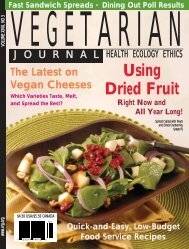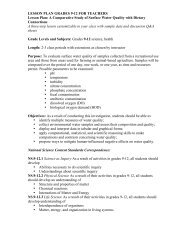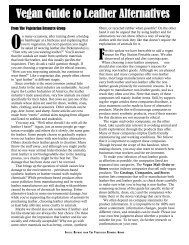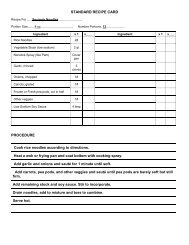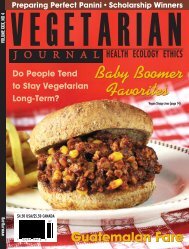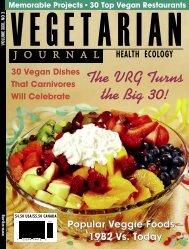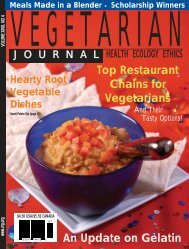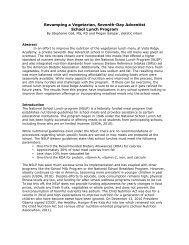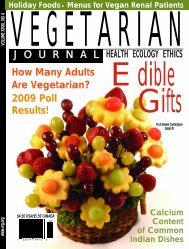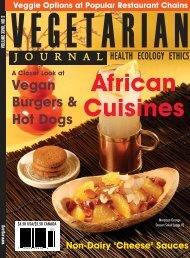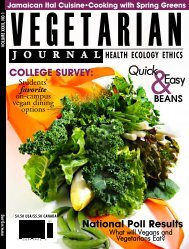Southwestern - The Vegetarian Resource Group
Southwestern - The Vegetarian Resource Group
Southwestern - The Vegetarian Resource Group
- No tags were found...
Create successful ePaper yourself
Turn your PDF publications into a flip-book with our unique Google optimized e-Paper software.
HOW MUCH VITAMIN D DO WE NEED?<strong>The</strong> current recommendation for vitamin D is 200IU per day for children and adults up to 50 years old,400 IU for 51-70 year olds, and 600 IU for those age71 years and older. 5 <strong>The</strong>se recommendations are morethan 10 years old. Because of more recent research onthe role of vitamin D, experts are suggesting intakes of800 IU or more per day for the average adult and 400IU for children, with higher intakes recommended totreat deficiency. 2,6CAN WE GET TOO MUCH VITAMIN DFROM FOOD OR FROM SUPPLEMENTS?WILL OUR BODIES MAKE TOO MUCHVITAMIN D?It is possible to get too much vitamin D, especially byoverdoing supplements. Excess vitamin D can causethe body to absorb too much calcium and can leadto kidney damage. <strong>The</strong> highest safe level of vitamin Dfor people to take is controversial, with some researchersusing up to 10,000 IU per day without seeing problems.2 A conservative recommendation is to stay below2,000 IU per day. 7 If you have had kidney stones,check with your health care provider before goingabove 1,000 IU per day. 7Don’t worry about producing too much vitamin Dfollowing sun exposure because your skin stops producingit once you’ve had enough. It’s still a good ideato limit sun exposure, however, because of the linkbetween sun exposure and skin cancer.IS VITAMIN D A SPECIAL CONCERNFOR VEGANS?A vegan diet can be planned to provide adequateamounts of vitamin D through use of fortified foodslike fortified soymilk. Any person, whether vegan ornot, who does not include good sources of vitamin Din his or her diet or take vitamin D supplements canbe at risk for not getting adequate vitamin D, especiallyif sunlight exposure is limited. Some studies have foundthat vegans have lower vitamin D intakes than do lactoovovegetarians or meat-eaters. 8 This may be becausecow’s milk (a source of vitamin D) is a more commonpart of the daily menu for non-vegans than vitamin D-fortified foods are for vegans.WHAT HAPPENS IF SOMEONE DOESN’T GETENOUGH VITAMIN D?A vitamin D deficiency leads to nutritional rickets,a condition that causes weak and deformed bones inbabies and children. Symptoms can include a delayin learning to walk, low height-for-age, and bowingof the legs and arms. Rickets rarely occurs in the U.S.,but a recent outbreak of cases has raised concerns thatchildren are not getting enough vitamin D.In adults, not getting enough vitamin D can increaserisk of osteoporosis and other diseases.WHAT’S THE DIFFERENCE BETWEENVITAMIN D 2 AND VITAMIN D 3 ?Two different forms of vitamin D are used in supplementsand fortified foods. Vitamin D 2 , also calledergocalciferol, is manufactured through the ultravioletirradiation of a substance called ergosterol that comesfrom yeast. Vitamin D 2 is vegan.Vitamin D 3 , also called cholecalciferol, is made bythe ultraviolet irradiation of a substance derived fromsheep’s wool. Some research suggests that vitamin D 2and vitamin D 3 are absorbed equally well, 9 althoughother studies suggest that vitamin D 3 is better absorbed. 10If you are treated for a vitamin D deficiency, you mayfind that your health care provider recommends takinga higher dose of vitamin D 2 than of vitamin D 3 tocompensate for possible differences in absorption. 2This is an area of active research that we will continueto follow.WHAT ABOUT VITAMIN D FOR BREASTFEDBABIES?Breast milk is the ideal food for infants. Human milk,however, contains little vitamin D. If a nursing motheris vitamin D-deficient, her breast milk will be evenlower in vitamin D than usual. To prevent vitamin Ddeficiency in breast-fed babies, the American Academyof Pediatrics recommends that breast-fed babies begiven a 400 IU/day vitamin D supplement beginningwithin the first few days after birth. 6Another possible way to prevent vitamin D deficiencyin a breast-fed infant is for the mother to takea vitamin D supplement daily containing up to 4,000IU of vitamin D. 11 High-dose vitamin D supplements,used by the lactating mother, have been shown tomarkedly increase breast milk vitamin D content. 11,12While there is some possibility that a baby will be ableto make adequate vitamin D following sunlight exposure,there are many factors that interfere with vitaminD production (skin pigmentation, pollution, season,amount of clothing, location, and sunscreen). This iswhy supplemental vitamin D is recommended.VEGETARIAN JOURNAL Issue Two 2009 9



